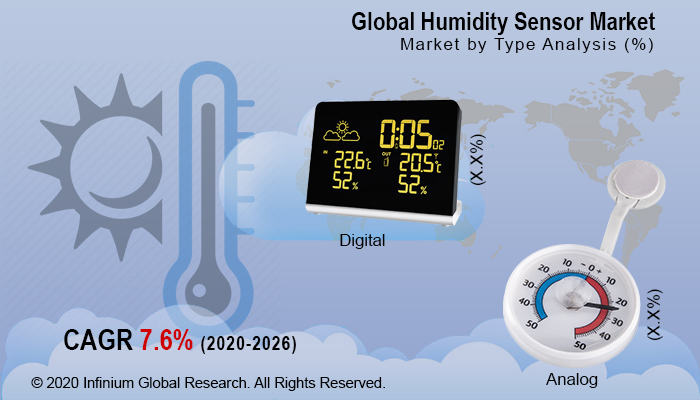Humidity Sensor Market (Product - Relative, RHS, RHT, and Absolute; Type - Digital, and Analog; End Use - Residential, Commercial, Automotive, Industrial, Agriculture, Weather Station, and Healthcare): Global Industry Analysis, Trends, Size, Share and Forecasts to 2026
A recent report published by Infinium Global Research on the humidity
sensor market provides an in-depth analysis of segments and sub-segments in the
global as well as regional humidity sensor market. The study also highlights
the impact of drivers, restraints, and macro indicators on the global and
regional humidity sensor market over the short term as well as long term. The
report is a comprehensive presentation of trends, forecasts, and dollar values of the global humidity sensor market. According to the report, the global humidity
sensor market is projected to grow at a CAGR of 7.6% over the forecast period
of 2020-2026.
Market Insight
Humidity sensors are sensors that transform the moisture content
in the air, gases, and soil or bulk materials into an electric output signal.
It is a humidity sensor device which is also recognized as hygrometer measures
and frequently updates the relative humidity in the air. It measures both air
moisture and air temperature. This sensor is composed of two metal plates with
a non-conductive polymer film amongst them. The film gathers moisture from the
air which causes minute changes in the voltage between the two plates. Humidity
sensors are commonly used in textile machines, woodworking machines, printing, and paper machines for measuring humidity in the air.
The key benefits of humidity sensors over conventional sensors are
low power requirement, easy implementation, and betterment of transducer
performance, for instance, sensing elements, structure design, the principle of
mechanism, and fabrication technologies. Owing to an increase in the number of
cement, food processing, pharmaceutical, and printing industries, the need for
humidity sensors is also increasing which is responsible for heavily driving
the growth of the humidity sensor market. Miniaturization of electronic devices
is one of the major trends in the global humidity sensor market during the
forecast period. Furthermore, technology advancement and increasing demand in
devices with high-end features are driving the market for humidity sensors. In
spite of these advancements, continuous reduction in prices of sensors because
of the introduction of more competitive technologies and higher associated
costs are detaining the market growth. The current COVID-19 epidemic that has
been devastating numerous countries across the world has undesirably affected
the overall sensor, control, and automation industry. While the capital investments
in the automation segment have been lethargic before the epidemic, they are
anticipated to be put on hold or postponed for at least a year. Conversely, the
recent standstill in industrial manufacturing and production is projected to
act as a wake-up call for the manufacturing sector on its reliance on human
labour. By way of IoT, industrial automation, and digitalization are
anticipated to become progressively significant to post-pandemic Tier 1
manufacturers, it may ultimately turn into an opportunity especially in
changing supply chains.
Among the geographies, the Asia Pacific region is expected to hold the largest share in the global humidity sensor market. Furthermore, the region is also expected to witness high growth and is anticipated to grow with a CAGR of 8.20% during the forecast period owing to the growing number of industries in countries such as China and India. India is fast advancing the deployment of numerous emerging sensors and IoT technologies and it offers an opportunity to deploy these emerging technologies at a larger scale to bring economies of scale. Moreover, Heavy investments and legislative initiatives on sensor technology in countries such as the U.S. and Canada are expected to generate considerable revenue in the North American humidity sensor market.
Segment Covered
The report on the global humidity sensor market covers segments such
as product, type, and end use. On the basis of product, the sub-markets include
relative, RHS, RHT, and absolute. On the basis of type, the sub-markets include
digital, and analog. On the basis of end use, the sub-markets include residential,
commercial, automotive, industrial, agriculture, weather station, and
healthcare.

Companies Profiled:
The report provides profiles of the companies in the market such
as Amphenol Advanced Sensors, Guangzhou Aosong Electronics Co., Ltd., Honeywell
International Inc., Laird Connectivity, Michell Instruments, Renesas
Electronics Corporation, Schneider Electric, Sensirion AG Switzerland, TE
Connectivity, and Texas Instruments Incorporated.
Report Highlights:
The report provides deep insights into the demand forecasts,
market trends, and micro and macro indicators. In addition, this report
provides insights into the factors that are driving and restraining the growth
in this market. Moreover, The IGR-Growth Matrix analysis given in the report
brings an insight into the investment areas that existing or new market players
can consider. The report provides insights into the market using analytical
tools such as Porter's five forces analysis and DRO analysis of the humidity sensor
market. Moreover, the study highlights current market trends and provides
forecast from 2020-2026. We also have highlighted future trends in the market
that will affect the demand during the forecast period. Moreover, the
competitive analysis given in each regional market brings an insight into the
market share of the leading players.
